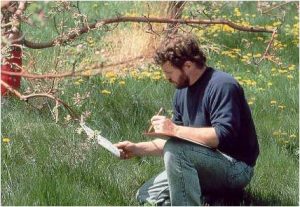Keys to monitoring pests:

Be sure that you have accurately identified the pest that causes the damage you are monitoring (see pest identification) and understand the pest’s biology and habits in the field or site being monitored. Pest populations vary from field to field, building to building, and year to year. Therefore, pest monitoring is site-, crop-, and pest-specific. Each situation will require specialized knowledge and tools (see insect monitoring traps and digital monitoring and decision tools).
Early detection of pests and pest conducive conditions function together like an early warning system for pests, helping to prevent or minimize a pest outbreak. Tracking environmental conditions like weather and food or harborage availability is very important. Pest management (computer) models analyze these data to project future populations, assist in determining if loss is likely to occur, and what tactics would be most effective.
Identify the effects of natural enemies by recognizing the organisms that are beneficial as biocontrol agents and determining if pests have been affected by them. Sometimes pests are kept in check by these organisms, and at other times the pest populations increase sharply.
Assessment:
Assessment is the interpretation of monitoring data (e.g., number of pests or signs of damage) that answers the questions: “Is the pest causing damage?”; “Are the current prevention or avoidance tactics working?”; and, “Is there a need to act?”. These questions center around the concept of an action threshold; the point at which corrective measures must be taken to prevent the pests in an area from causing unacceptable injury or harm. The art and science of assessing pest populations and making management decisions are basic elements that separate IPM from other pest management strategies. Further explanation of the threshold concept is described below.
Understanding thresholds:
Before any suppression action is taken, the IPM approach considers if the pest has exceeded a pre-set action threshold; the point at which the pest population or environmental conditions indicate that pest control action must be taken. Thus, finding a single pest or even very low numbers of pests does not always result in taking action. Keep in mind that thresholds are crop- and pest-specific, as well as weather-related Some pests in a field may be below the threshold while others are above it.
The following five factors are considered when setting action thresholds:
- Economics. Economic thresholds for many pests (primarily insects) and crops have been carefully determined. A grower should not manage the pest until the population, or damage that it causes, reaches a level where the risk of economic loss is certain.
- Health and safety concerns. When the pest creates a health or safety concern, the action threshold is set low. For example, if Lyme disease, eastern equine encephalitis, or West Nile virus is prevalent in or near a playground and the mosquitoes or ticks that transmit the diseases are found, then this would trigger the action threshold-regardless of if it is one mosquito or a hundred.
- Aesthetic concerns. When the appearance (aesthetics) of something is degraded, then that triggers an aesthetic concern, for example, bird droppings on statues and monuments, or defoliation of landscape plants or high value horticulture crops.
- Public opinion. It may be less obvious, but public opinion will often result in an action threshold being set very low. Whether the reason is social, cultural, or psychological, some creatures, like spiders, are pests because they may be dreaded at any level.
- Legal requirements. Certain pests must be controlled under federal, state, or county health regulations. Therefore, action levels are being set by regulation (see regulatory control in the IPM tactics page). For example, there is virtually no tolerance for mice, rats, flies, cockroaches or any other pests in food facilities. If a public health emergency is declared, government agencies may mandate pest control in the event of a rabies or encephalitis outbreak. Building codes and standards may determine action to control termites, rats or flies on private or commercial properties and public areas, including parks or schools. And, in agricultural crops, there may be quarantine areas where pests must be treated to avoid their spread to other crops or sites.
___________________